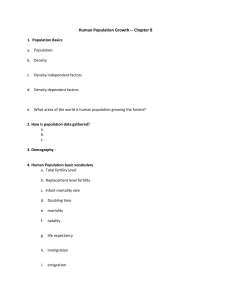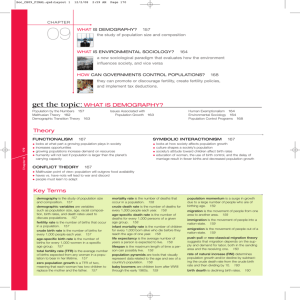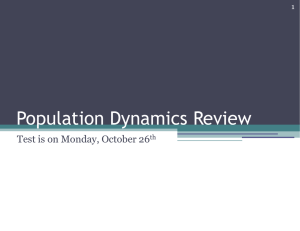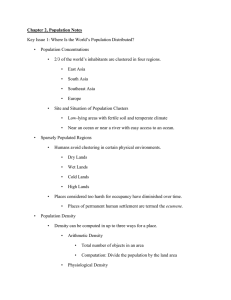Demographic Terms (MSWord)
advertisement
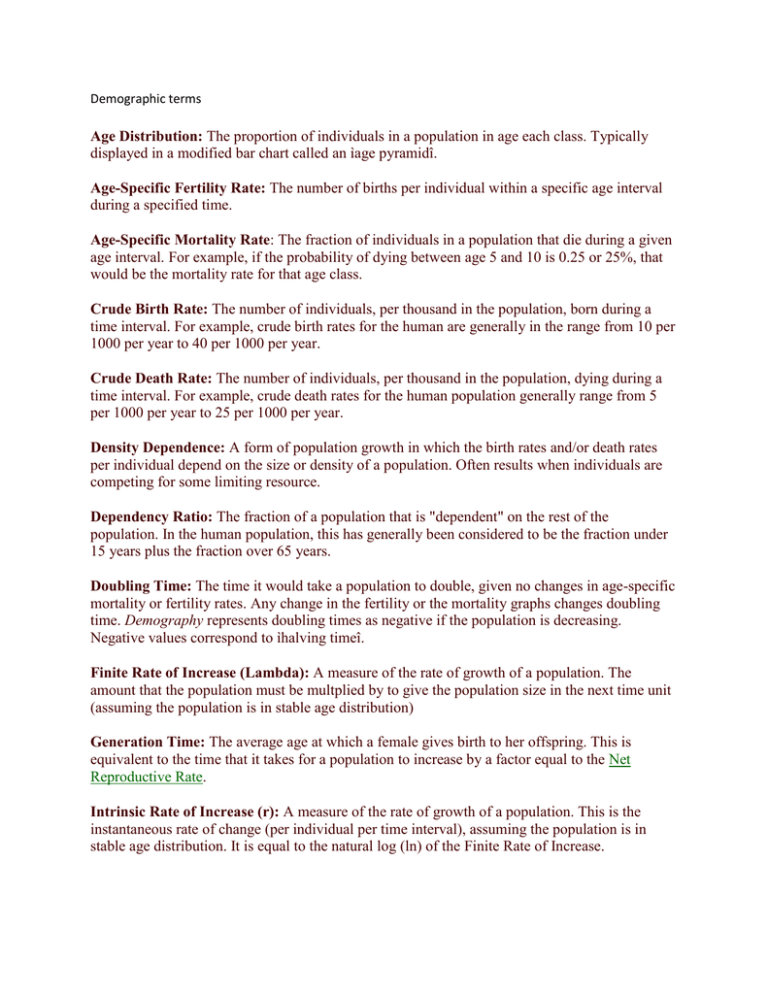
Demographic terms Age Distribution: The proportion of individuals in a population in age each class. Typically displayed in a modified bar chart called an ìage pyramidî. Age-Specific Fertility Rate: The number of births per individual within a specific age interval during a specified time. Age-Specific Mortality Rate: The fraction of individuals in a population that die during a given age interval. For example, if the probability of dying between age 5 and 10 is 0.25 or 25%, that would be the mortality rate for that age class. Crude Birth Rate: The number of individuals, per thousand in the population, born during a time interval. For example, crude birth rates for the human are generally in the range from 10 per 1000 per year to 40 per 1000 per year. Crude Death Rate: The number of individuals, per thousand in the population, dying during a time interval. For example, crude death rates for the human population generally range from 5 per 1000 per year to 25 per 1000 per year. Density Dependence: A form of population growth in which the birth rates and/or death rates per individual depend on the size or density of a population. Often results when individuals are competing for some limiting resource. Dependency Ratio: The fraction of a population that is "dependent" on the rest of the population. In the human population, this has generally been considered to be the fraction under 15 years plus the fraction over 65 years. Doubling Time: The time it would take a population to double, given no changes in age-specific mortality or fertility rates. Any change in the fertility or the mortality graphs changes doubling time. Demography represents doubling times as negative if the population is decreasing. Negative values correspond to ìhalving timeî. Finite Rate of Increase (Lambda): A measure of the rate of growth of a population. The amount that the population must be multplied by to give the population size in the next time unit (assuming the population is in stable age distribution) Generation Time: The average age at which a female gives birth to her offspring. This is equivalent to the time that it takes for a population to increase by a factor equal to the Net Reproductive Rate. Intrinsic Rate of Increase (r): A measure of the rate of growth of a population. This is the instantaneous rate of change (per individual per time interval), assuming the population is in stable age distribution. It is equal to the natural log (ln) of the Finite Rate of Increase. Mean Life Expectancy: How long an individual can be expected to live, on average. This is influenced only by the age-specific mortality graph. Net Reproductive Rate (R0): The average number of offspring an individual in a population will produce in his/her lifetime. Unlike the Total Fertility Rate, R0 depends on age specific mortality rates. Population Momentum: The tendency for a rapidly growing population to keep on growing, even after the implementation of policies designed to halt population growth. Sex Ratio: The fraction of the population that is female. Technically, this value is not a "ratio", but this has become a common way of representing the gender distribution of a population. The primary sex ratio is the proportion of births that are female. Stable Age Distribution: The age distribution which the population will reach if allowed to progress until there is no longer a change in the distribution. Survivorship: The probability that an individual survives from age zero to a given age. Total Fertility Rate (TFR): The total number of offspring a female would have, on average, if she were to live to the maximum age. (Compare with Net Reproductive Rate)
